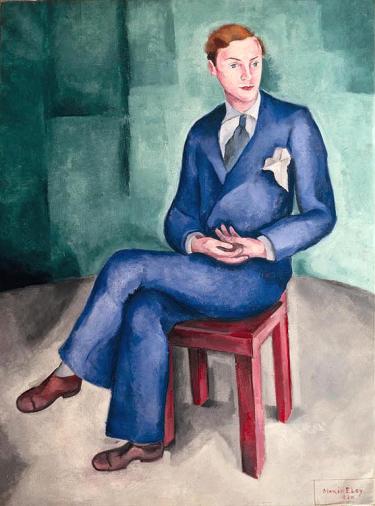Description
Mario Eloy, an outstanding exponent of Portuguese modernism, achieves in his work "Portrait of the dancer Francis" of 1930 a perfect synthesis between the representative and the abstract, an approach that reflects the creative tension of his time. This painting, which transmits a deep sense of dynamism and expression through its composition, presents the dancer Francis at a time of great intensity. The dancer's posture is almost sculptural, captured in a position that suggests movement, which evokes the effervescence of ballet, as well as the energy and passion inherent in dance.
The use of color in this work is remarkable. Eloy opts for a palette that plays with warm and cold tones, creating a vibrant contrast in the background that highlights the central figure of the dancer. The colors, in a constant dialogue, seem to interfere with each other, which reinforces the idea of movement and the transience of the action. The bright yellow and the deep blue, present at the bottom and the dancer of the dancer, generate an almost dreamlike atmosphere that floats beyond the mechanical context of a conventional portrait. This chromatic choice can be interpreted as a representation of the emotional states of the dancer, a common characteristic in Eloy's work.
As for the dancer figure, its anatomy is represented in a stylized way, a feature that aligns with the avant -garde currents of the moment. Eloy seems to make a call to the representation of art as an expressive organ that goes beyond the mere reproduction of the model. In this sense, the fabric not only captures a portrait, but also evokes the essence of the performer, mixing the physical with the spiritual. It is fascinating to observe the subtleties of the dancer's face, which, although not overloaded with details, transmits an expression of concentration and delivery that make it universal.
It is also relevant to mention the artistic context in which Mario Eloy developed his career. Throughout his production, the author experienced with various techniques and styles, influenced by Cubism and Expressionism, which is evident in this work. "Portrait of the dancer Francis" is inserted in a period where the human figure begins to be reimagined not only as an aesthetic object, but as a form of emotional and personal communication. This work, in particular, is at the intersection between the portrait and exaltation of the artistic figure, distancing from traditional portraits to offer a more dynamic and subjective vision.
In the light of this work, it is possible to establish a dialogue with other contemporary painters who also explored the theme of the body in motion, giving voice to the vitality of the human being. The pieces of artists such as André Derain and Henri Matisse can serve as a comparison in the search for new expressions of the human figure in painting. Thus, "Portrait of the dancer Francis" not only stands as a central piece within the Eloy Mario corpus, but also in a broader conversation about the perception of movement and emotion in the pictorial representation of dance and the Art in general.
In conclusion, Mario Eloy, through "Portrait of dancer Francis", gives us more than a simple portrait; It offers us a visual experience that invites reflection on the nature of art and dance, its interrelation and its ability to transmit deep emotions. This work, therefore, becomes a testimony of the ability of the artist and the cultural Zeitgeist of the time, in a sequence full of tension, color and movement.
KUADROS ©, a famous paint on your wall.
Hand-made oil painting reproductions, with the quality of professional artists and the distinctive seal of KUADROS ©.
Art reproduction service with satisfaction guarantee. If you are not completely satisfied with the replica of your painting, we refund your money 100%.

